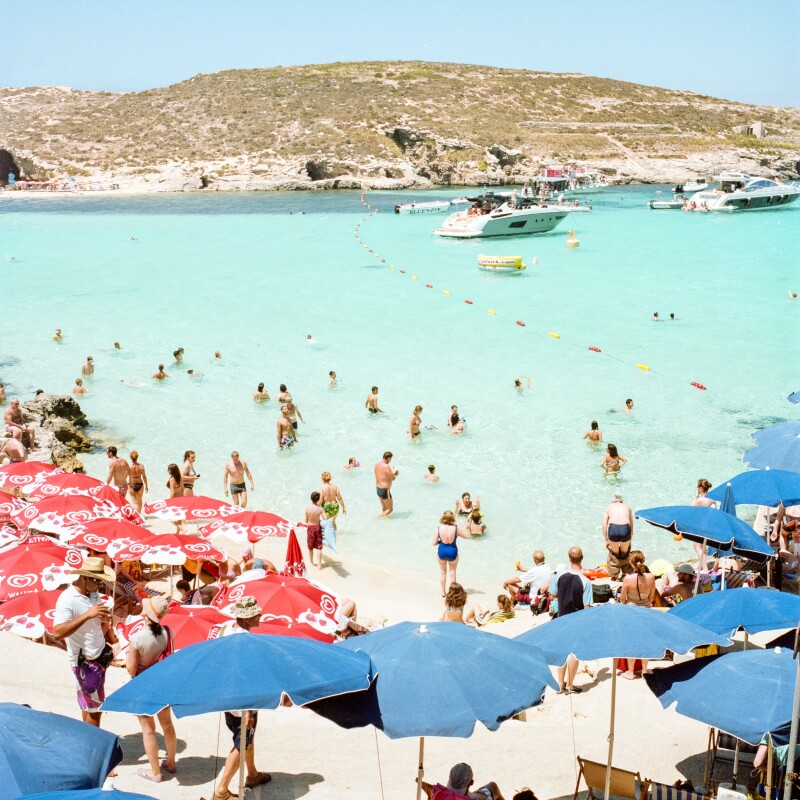For a small, unassuming, and almost idyllic country isolated in the middle of a sea, Malta has a surprisingly storied past that almost feels tangible in the Mediterranean air. The distinct honey-colored buildings in the UNESCO-designated capital of Valletta—also a 2018 European Capital of Culture—are literally built on history, including vestiges of 16th-century Knights of Malta. The strategically located country has been handed down through a succession of empires from the Phoenicians to the Romans and all the way to the British in the 19th century, surviving Ottoman sieges and Nazi bombs along the way. But despite this depth of culture and long history, Malta still feels serenely lost in time.
For photographer Mark Wickens, Malta had always had an air of mystery thanks to the fortune-telling sisters Creta and Malta in Haruki Murakami’s surreal novel The Wind-Up Bird Chronicle. But more like a shipwrecked St. Paul (who, legend has it, brought Christianity to the island in 60 C.E.) than the Game of Thrones pilgrims who now flock to the island, Wickens found himself in Malta almost by accident.
Having left a career in architecture to pursue one in photography, Wickens was traveling through Europe in search of inspiration and experience. “I packed a backpack with a Hasselblad camera, which is a Swedish medium-format camera, and a bunch of Kodak film, and set off,” he says. “I didn’t really try to end up in Malta, but somehow found my way there.” Here, he shares some of his photographs of the country.

Photo by Mark Wickens
The Maltese archipelago is composed of three main islands and several uninhabited minor islands. A ferry connects the biggest island, Malta, with the smaller Gozo island and with Comino, the tiny island in the middle.

Photo by Mark Wickens
“Everything in Valletta and on the island of Malta is built out of the same sort of golden limestone mined from the island,” says Wickens. “It’s kind of a rocky island, so it feels like all of the buildings are sort of rising out of this rock formation.” In fact, the country boasts some of the oldest megalithic-era buildings in the world. “It’s a very insular building culture, too, that doesn’t seem to have any significant outside influences. Everything new and old still feels like a big homogenous block. Not like, say, San Francisco where there are all these Victorians and then this modern condo somewhere.”

Photo by Mark Wickens
Wickens rented a place on Gozo, calling it a much sleepier island than Malta. “We would spend the day driving around to all of these amazing rock formations and cliffs, and there’s maybe one or two other people there at most, but it was pretty barren. It’s a pretty wonderful place.”

Photo by Mark Wickens
Each village in the very Catholic country has a patron saint. During the summer, a rotating schedule of festa (feast) days, which celebrate the different saints, means that it’s not hard to find a village decked out in all its celebratory finery. But still, Wickens says, the midday heat rules the festivities. “It’s so hot in the middle of the day that I think everyone heads indoors, but I was wandering around everywhere. It often felt like a ghost town.”

Photo by Mark Wickens
“Everywhere you drive on the island has somewhere you can swim,” says Wickens. “You find a little beach for the day and when it gets too hot, go inside and have lunch at a little café, and then maybe just go to a bar in the evening. It’s a pretty low-key place.”

Photo by Mark Wickens
“Part of being on the Mediterranean,” Wickens says, “is that light reflects off things in a pretty unique way. I always say that every place you visit in the world has its own color palette and quality of light. Malta, in particular, has this golden hue because of the rocks of the island and that’s complemented by this bright blue [water] that surrounds it.”
>>Next: Go Inside the Quirky “Micronation” of Molossia Through These Brilliant Photos











